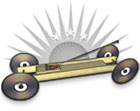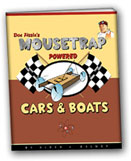Mousetrap Vehicles: Center of Mass
The center of mass is the location where the mass of an object is considered to be located. Learn all about center of mass and how it applies to mousetrap racers.
Center of mass is simply the average position of all the particles of mass that make up an object. For symmetric objects of uniform density, such as a ball or a book, this point is usually at the geometrical center. But an regularly shaped object, such as a baseball bat, will have more mass at one end, causing the center of mass to be located closer to the larger end. If a ball is thrown through the air, it will follow a smooth trajectory. In contrast, if a baseball bat is thrown through the air, it will seem to wobble all over the place. The bat is actually wobbling around a single point its center of mass and that center of mass will follow a smooth trajectory.

bonus tip: Heat and sound are forms of energy caused by friction.
Center of Mass and Wheels
An object thrown into the are with a spin will rotate freely around their center of mass travels (i.e., most energy efficient). But objects that are fixed or that are forced to rotate around a point that is not their center of mass will in essence wobble around this point and consume more energy than if allowed to rotate around their center of mass. Larger wheels are affected more adversely by an offset center of mass than smaller wheels. If the center of mass of a large wheel is not in it's center then the wheel will tend to wobble through its journey wasting energy and decreasing the overall distance the car will travel.

bonus tip: when the center of mass is not at a wheels center, the wheel will wobble and waste energy.
Also, it is possible for a vehicle to lose distance after stopping and begin rolling backward if a wheels center of mass comes to rest on the wrong side of the wheel; this occurs when the center of mass for a large wheel becomes located in an unstable position. As the center of mass begins to fall towards a more stable position the wheel begins to rotate, causing the car to move either backward or forward. If the car moves forward, it will gain additional distance after stopping, but there is no way to predict where the center of mass will come to rest when the car stops. For this reason, it is best to balance a large wheel, forcing the center of mass to be located through the axle.

bonus tip: if the center of mass for a large wheel is not at it's center, the wheel may come to rest at an unstable position causing the vehicle to rock backwards from it's stopping point.
Large wheels should be balanced, especially if you have removed material from portions of the wheel in an effort to lighten the car. To balance a wheel, you should hold the wheel by the axle and allow it to turn freely. The heavier side of the wheel will fall to- wards the bottom. Once the heavier side is marked, mass can be added to the opposite side until the wheel has no tendency to rotate when suspended freely by the axle. Any material can be used to add mass to a large wheel, but clay and pennies are easy to work with

bonus tip: A small amount of clay can be used as a balance weight in order to make sure a large wheel's center of mass is at it's point of rotation.
*Can't find what you're looking for? Ask Doc Fizzix »




